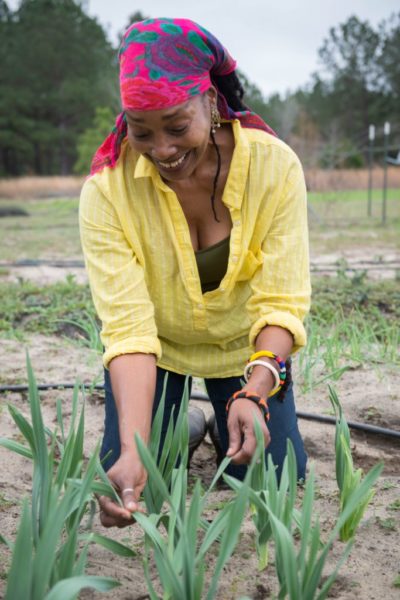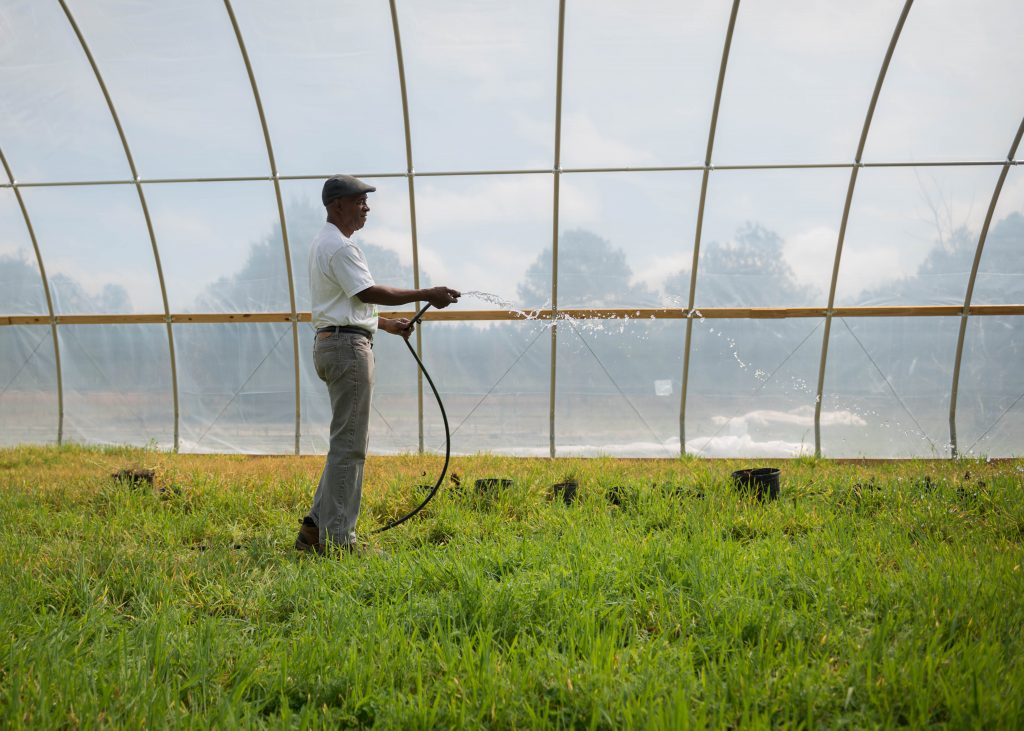
Miss Lola, a sharecropper in Glenwood, Georgia, in the 1940s, was offered the rare opportunity of buying the land that she had been tending for years. “My mother and her five brothers worked so hard to help raise the money—cleaning house, cooking for folks, doing outside farm work, whatever they could. My grandmother even had the community moonshine thing going on,” says Jennifer Taylor, Lola’s granddaughter. “When the landlord came to see if she had the funds to buy the farm, she did.”
Lola’s farm flourished, producing abundant harvests of poultry, vegetables, peaches, pecans, sugarcane, dairy items, and more. “She made and sold soap and canned goods—a lot of what we call ‘value-added’ now,” Taylor says. When Lola’s children and grandchildren moved away from the farm, she sent them baskets of her harvest. And she earned a reputation for sharing food with others in her community.
As Lola grew older, she could no longer do the farm work, and the land lay fallow. In 2010, Taylor, along with Ronald Gilmore, her husband, returned to her grandmother’s farm and relaunched it as Lola’s Organic Farm.
Taylor studied agronomy at Florida A&M and Iowa State universities, ultimately earning her doctorate degree and a position teaching organic farming at the former, in Tallahassee. She’s now the coordinator of the Florida A&M Statewide Small Farm Program. “I was raising a family and studying farming,” she says. “I envisioned my grandmother’s farm as a place where I could grow healthy food for my family and teach others about organic growing.”
Fresh Start
The farm today is 32 acres of certified-organic land, with the majority in woodlands. The couple work 3 acres, raising strawberries, blackberries, muscadine grapes, persimmons, apples, figs, and pomegranates, along with onions, peppers, several varieties of kale, sweet potatoes, Asian eggplants, ginger, and turmeric. Georgia’s climate and high tunnels allow them to grow year-round.
“We’re small, so we need to grow items that our customers really want but will not find easily” from other sources, Taylor says. The farm’s harvest is sold to regional food distributors, to a co-op that offers it directly to customers through local farmers’ markets, and to a variety of grocery stores and restaurants in the area.
The two-person operation is low-tech. “We do most of the work with hand tools—shovels or hoes,” she tells us. “We contract with some of our neighbors to cultivate and do other jobs that need big equipment.” Their watering method is what Taylor calls “rain-fed agriculture,” which they supplement with a microirrigation system funded by a program from the USDA’s Natural Resources Conservation Service (NRCS).
A clear division of labor helps Gilmore and Taylor get all the work done. “He says I’m the administrator and he’s the assistant, but he’s an organic farmer extraordinaire,” Taylor says. “I do the crop and variety selection and help him with the planting and care. I handle the grant writing and developing the marketing contacts. He takes care of the crops on a day-to-day basis.”

Potatoes vs. Weeds
The farm’s soil is “Fuquay loamy sand,” says Mark Schonbeck, Ph.D., an experienced researcher, teacher, and consultant who has worked with the couple. “Most coastal plain sandy soils in the Southeast have a clay-enriched B horizon that begins 12 to 18 inches below the surface. It can act as a moisture and nutrient reserve for crops, provided that deep-rooted cover crops and other good practices are used to prevent hardpan and maintain good health through the soil profile. Fuquay soil has a very thick [2 to 3 feet], sandy E horizon between the A [topsoil] and more clayey B. It’s one of the more challenging soils I have seen.”
Bermudagrass proved to be another obstacle. “On the one hand, it prevents soil erosion,” Taylor says, “but when you’re trying to grow vegetables, it’s a real problem.” With a grant from the USDA’s Sustainable Agriculture Research and Education program and guidance from Schonbeck, the couple set up a comparison of two systems for controlling the weed: use of intensively planted cover crops—a rotation of field peas, millet, and buckwheat—versus multiple tillage passes.
“The difference was easy to see,” she reports. “The vegetables following cover crops had much more vigor” than those grown in the tilled plots. She also found better soil structure and more microbial activity in the plots where the cover crops grew. The farmers have since added barley, hairy vetch, and subterranean clover to their cover crop regimen.
Along the way, they observed that the Bermudagrass was helping to control nutsedge, another pesky weed on their farm. With some experimentation, they discovered that intensive planting of sweet potatoes also controls nutsedge. “Now we plant them for both weed control and food,” Taylor says.
Sharing Knowledge
While producing food for themselves and their community, Taylor and Gilmore also devote time and energy to teaching other farmers. At their annual farm day, other growers come to learn about organic farming practices that work in their region.
“We see ourselves as a demonstration farm that shows strategies for intensive growing,” Taylor says. “People come from all over the state to see what we are doing. Last year, we put up our second high tunnel through the NRCS high tunnel initiative [which covers some costs of building one]. The program is a great help to farmers, especially beginning organic farmers. So we had a workshop that covered the benefits [of high tunnels], how to get the grant, and how to build one.”
Taylor, who served on the National Organic Standards Board (NOSB) from 2011 to 2016, and Gilmore chose to be certified organic right from the start. “We saw it as a market advantage for our customers to know what processes we use to produce the food they eat,” Taylor says. “We knew [organic farming] is healthier for them and for us.”
The pair’s commitment to the organic label extends beyond the farm and its customers. “At our workshops, we talk to farmers about organic certification, and a lot of what farmers have heard about often isn’t true,” she continues. “They believe that so much paperwork is involved, but I tell them all you’re doing is making a plan and keeping track of what you planted and what you did to take care of [the crops]. As a farmer, you need to have a plan even if you don’t get certified. All you have to do is write it down and share it with your certifier.”
 Joining the Cause
Joining the Cause
Taylor now serves on the Organic Farmers Association Governing Council and is the vice chair of the OFA Policy Committee. “I see it as a great opportunity. Organic farmers [have] to find their voice in their own community and bring that to the public,” she says.
While serving on the NOSB, Taylor advocated for training on how to avoid contamination of organic farms. “We need to be equipped with the knowledge and skills to keep our land protected from neighbors who are using contaminating pesticides, herbicides, and GMOs. Conservation land needs to be protected—and fallow land too.”
Taylor believes a publicity campaign is needed to explain to consumers why the certified-organic label is so valuable to them. “There’s so much confusion in the marketplace with lots of different labels claiming to be ‘natural,’ ” she says. “We need to help the public understand and appreciate the full breadth of the meaning of USDA certified organic and its benefits for the environment, for the farm and farmers, for the consumer.
“Organic farmers are examples to their communities, to other farmers,” she adds. “It’s a different kind of living, and as an organic farmer, you’re showing what it means to live an organic way of life.”
Fast Facts
Location: Glenwood, Georgia
Size: 3 cultivated acres (32 acres total)
Products: Fruits and vegetables, ginger, turmeric
First year farming: 2010
Organic certification: 2010
OFA membership: 2016
Learn more: Search “Lola’s Organic Farm” on Facebook
